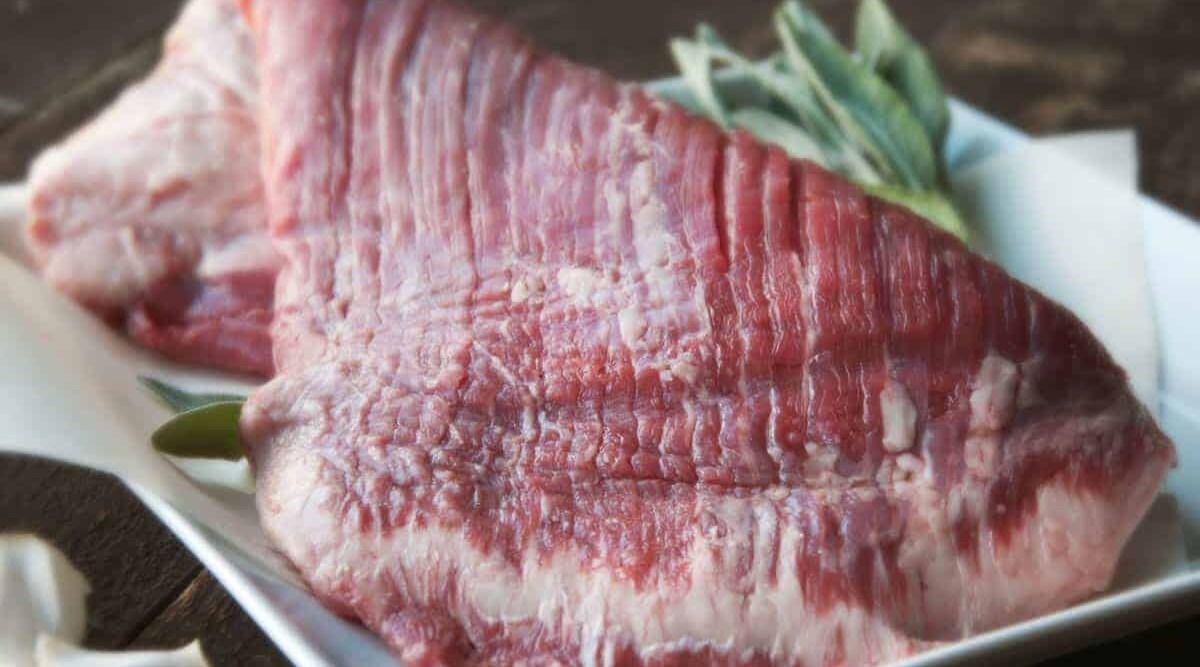
Flank steak is a flavorful, lean cut of beef that comes from the lower abdominal area of the cow and is known for its distinctively long, oblong, flat shape and fibrous texture.
Flank steak is one of the most delicious yet potentially challenging cuts of meat. It requires careful handling and cooking techniques to enhance flavor and avoid a too-tough texture.
If you’re not familiar with flank steak and haven’t cooked it before, you’re about to discover a delightful experience.
In this article, I’ll share the essentials about flank steak, including where it comes from on the cow, alternative names, selection tips, and best cooking methods. Plus, I’ll reveal a substitution secret often used by butchers and chefs if flank steak isn’t available.
Once you learn to select and prepare it correctly, flank steak might become one of your favorite beef cuts.
Key Takeaways
- Flank steak is a flavorful and lean cut of meat that can be challenging to cook properly.
- Flank steak comes from the steer’s flank, below the loin and sirloin, and is known for its lean and tough nature.
- Alternative names for flank steak include London Broil, Flank Steak Fillet, Jiffy Steak, Bavette steak (in French), and Arrachera (in Spanish).
- Flank steak has a rich, beefy flavor and a grainy, fibrous texture. It is best cooked to medium-rare or medium and sliced thinly against the grain.
- Flank steak can be cooked hot and fast on the grill or long and slow by braising. It absorbs flavors easily and is popular for grilling and barbecuing.
- Alternative cuts like skirt steak and hanger steak can be used as substitutes if flank steak is unavailable.
- Flank steak is versatile and suitable for various dishes, from sandwiches to stir-fries.
- When buying flank steak, look for a deep red color with minimal fat and connective tissue.
Jump to:
- 1 Key Takeaways
- 2 My Experiences With Flank Steak
- 3 What is Flank Steak? Where does it Come From?
- 4 Other Names for Flank Steak
- 5 Flavor, Texture, Fat Content, And Tenderness
- 6 Its Versatility
- 7 Flank Steak Nutritional Info
- 8 Portion Size: How Much Bottom Flank Steak Per Person?
- 9 Alternative Cuts to Use Instead of Flank Steak
- 10 The Best Dishes for Flank Steak
- 11 Buying Flank Steak
- 12 Where to Buy Flank Steak Online
- 13 Final Thoughts
My Experiences With Flank Steak
Flank steak has become a key part of my BBQ repertoire thanks to its lean, flavorful nature. It cooks quickly and goes well in quick dishes like rolls, sandwiches, stir-fries, and salads. So it is perfect for non-time-consuming lunches and snacks.
It has a very bold, beefy flavor and takes on other flavors really well, particularly when marinated for a few hours. This marination, which I highly recommend, not only adds extra depth to its taste but also helps to soften its otherwise inherent toughness.
For rolls and sandwiches, I favor a simple seasoning of salt and pepper to let the meat’s natural flavors shine through. Then grill it super-hot and super-fast to create a perfect char on the outside while keeping it tender inside. Slice it very thin against the grain, and it’s then wonderful with a strong sauce like my chimichurri or a hot sauce of your choice.
When using it in stir-fries, I like to grill it separately and add it to the rest of the dish at the end. I find stir-frying it along with the other ingredients leads to it being too tough and chewy; it’s just too hard to get right, and it’s far easier to get better results on the grill.
In my view, this underrated cut deserves more acclaim in the BBQ community. It’s fantastic for any dish where you want thinly sliced pieces of beef that are a vehicle for carrying other flavors.
What is Flank Steak? Where does it Come From?
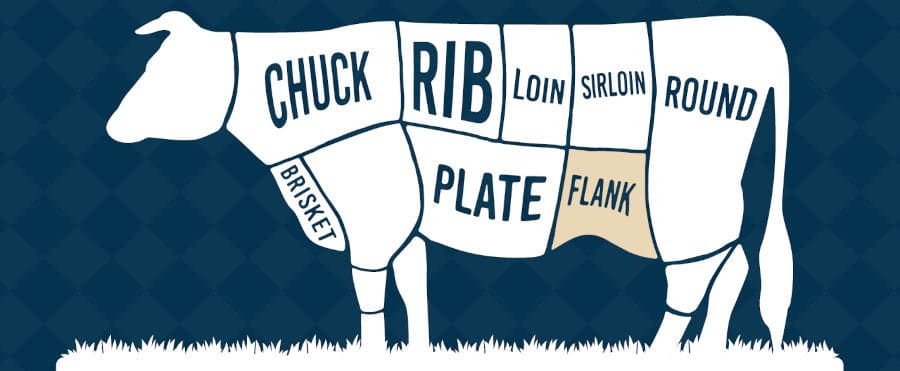
The name gives it away. Flank steak comes from the flank of the steer, below the loin and sirloin. (click here to learn more about these other cuts of beef.)
It sits in the abdominal area of the animal near the bottom. It helps the cow to twist and walk, so the muscle works A LOT. It is tough, lean and has long thick muscle fibers.
One end is about ¾ to one-inch thick tapering down to about 1/2 inch on the thinner end. Sometimes you’ll see some fat on the thinner end. The muscle sits in an area surrounded by fat, but itself is very lean.
Other Names for Flank Steak
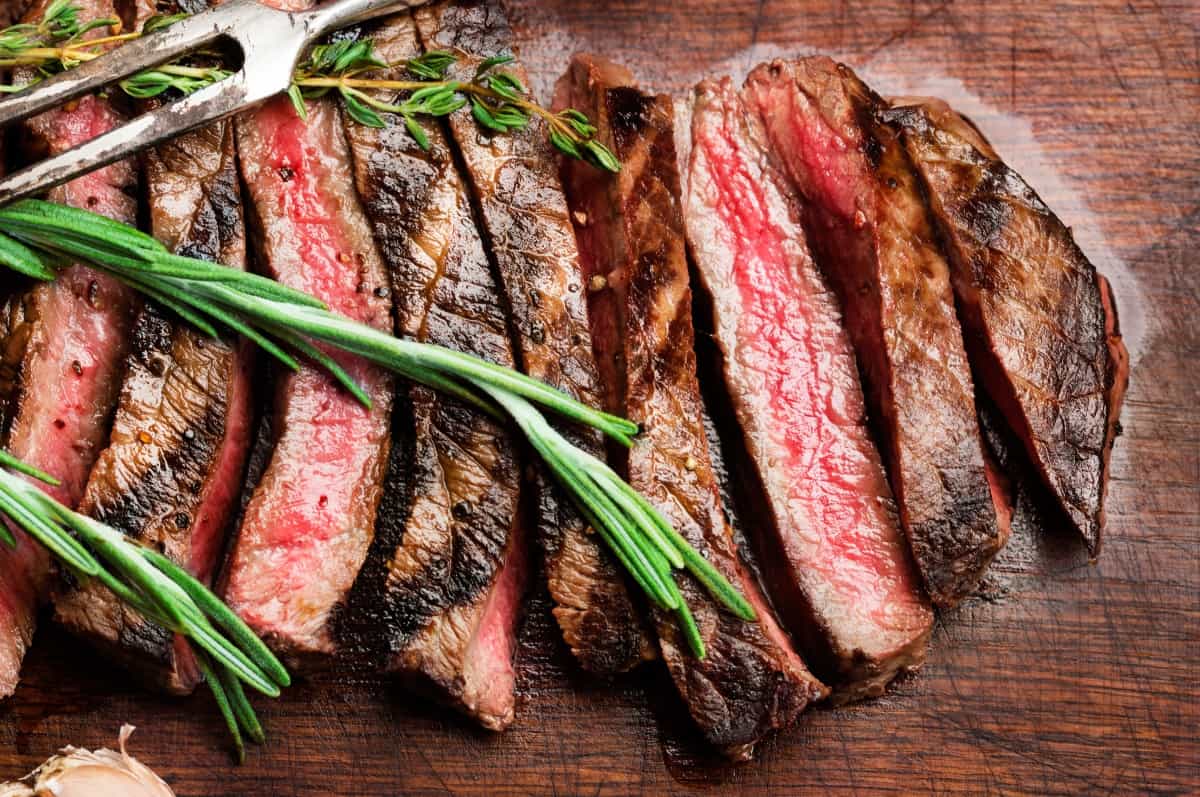
There are a handful of other names for flank steak, one of the most common being London Broil. You’ll sometimes see it written that way in the grocery store or on a menu. However, stores also use top round as “London Broil” so you need to know what it looks like to be sure you’re buying the right cut.
Two lesser known terms are Flank Steak Fillet and Jiffy Steak. If you happen to be in an ethnic market or out of the country, look for Bavette steak in French and Arrachera in Spanish.
When in doubt, ask the person at the meat counter.
Flank is prized by cooks and chefs around the world for its flavor and texture, so it’s available in most countries and hence due to language differences, under different names.
Flavor, Texture, Fat Content, And Tenderness
Flank steak is a flavorful, lean, and somewhat tough cut that, when cooked and sliced correctly, offers a delightful eating experience, especially for those who appreciate meat with a hearty beef flavor and a chewier texture.
Flank steak is known for its rich, beefy flavor, stronger than many other cuts. Its robust taste works well with strong marinades and spices, ideal for grilling and barbecue.
Flank steak has a grainy and fibrous texture with a visible muscle grain. Though not naturally tender, this texture becomes enjoyable when cooked and sliced correctly. Cutting against the grain is crucial, as it shortens muscle fibers and aids in chewability.
This lean cut has minimal fat marbling, resulting in a firmer texture than fattier cuts. While it lacks the natural tenderness of cuts like ribeye, its low fat makes it a healthier choice.
Flank steak is not inherently tender due to its muscle structure and low fat. However, tenderness improves with marinating and cooking to medium-rare or medium. Slicing thinly against the grain also makes it more tender and enjoyable.
Its Versatility
There are two opposite cooking choices with flank steak. You either cook it hot and fast, or long and slow by braising.
The main idea is to break down the connective tissues by cutting very thin slices, or to break down the toughness by heat and moisture.
Fast Grilling Keeps The Meat Tender
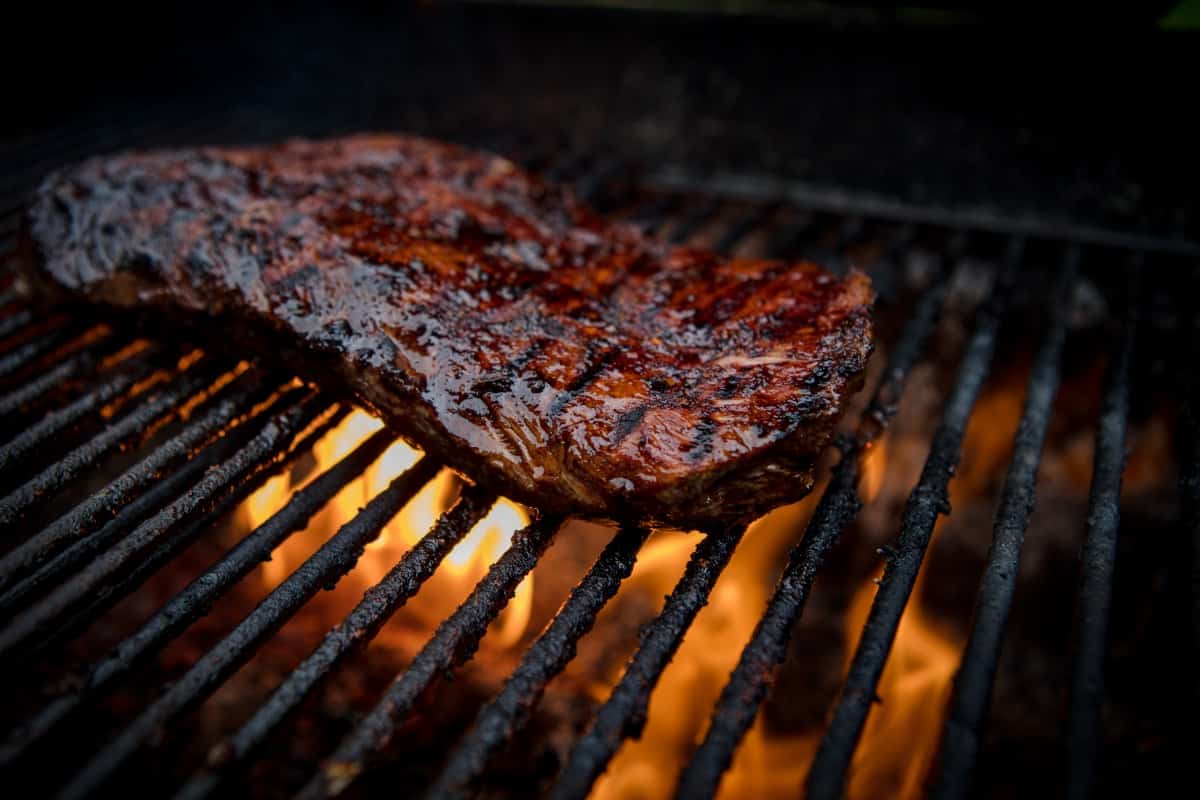
When I say hot and fast, if you can dangle it behind a jet’s afterburner, that’s what you want. Otherwise, use a scorching charcoal fire and sear for just a couple of minutes on each side before slicing, the afterburner steak method is perfect for this.
You don’t ever want to cook it past medium-rare, or it will get VERY chewy. And make sure to let the steak rest for about ten minutes before you slice it because it’s one of those cuts where all the juices come pouring out in huge quantities if you slice it before it’s rested. Do not do this! It makes it drier and more chewy.
And when you cut it, make sure it’s across the grain and cut on the bias. That means don’t hold your knife straight up and down like slicing bread. Instead, hold the knife at a 45-degree angle to make wider slices.
Marinating for 12 to 24 hours can help add moisture and tenderize the meat, but can sacrifice a strong Maillard crust.
The beauty of flank steak is that it absorbs the flavors of any rub or marinade easily as it’s thin and there’s so much surface area between the string-like muscle fibers. This is what makes it one of the most popular steaks for grilling.
Braising Flank Makes A Great Gravy
To break down and tenderize the connective tissues in the muscle, braising is another great way to go. You can braise thick pieces by cutting the flank steak into four or five portions.
Another method is to cut slices and pound them to tenderize. Then add a filling, roll and stick with a toothpick to make roulades.
Once the meat is ready, you can brown it in a deep skillet, add your cooking liquid and simmer for 2 to 3 hours. Flank’s beefy flavor enhances any sauce you’re making with it.
Although stir-frying is a quick cook method, you’ll find flank steak will be too chewy. Some of its substitutes will make better choices.
Flank Steak Nutritional Info
| Nutrition | Total Amount (Based on 3 oz Serving) | % Daily Value (based on 2000 calories/day) |
|---|---|---|
| Calories | 116 | 5.8% |
| Total Fat | 4.3g | 5% |
| Saturated Fat | 1.8g | - |
| Sodium | 45.1mg | 2% |
| Protein | 18.2g | 36% |
| Iron | 1.3mg | 7% |
| Zinc | Zinc 3.3mg | 30% |
Portion Size: How Much Bottom Flank Steak Per Person?
The recommended portion size for flank steak varies depending on several factors, including the meal type, the diners’ appetites, and whether it’s the main dish or part of a larger meal. Here are some general guidelines:
For a main course, a typical portion size of flank steak is about 6 to 8 ounces (170 to 225 grams) per person. This amount is sufficient for most adults, especially when served with side dishes like vegetables, grains, or salad.
You can reduce the portion size if flank steak is part of a mixed dish, such as in a stir-fry, salad, or fajitas. In these cases, 4 to 6 ounces (115 to 170 grams) per person might be enough, as the meat is combined with other ingredients, contributing to the meal’s overall size.
You may need to adjust to cater to different appetites and preferences. Some people like a lot more meat, while others may be on a low-protein diet.
It’s also important to remember that flank steak tends to shrink a bit when cooked, so you’ll want to account for this when purchasing and portioning the meat. Calculate what you need, then add 20% is what I like to do.
Alternative Cuts to Use Instead of Flank Steak
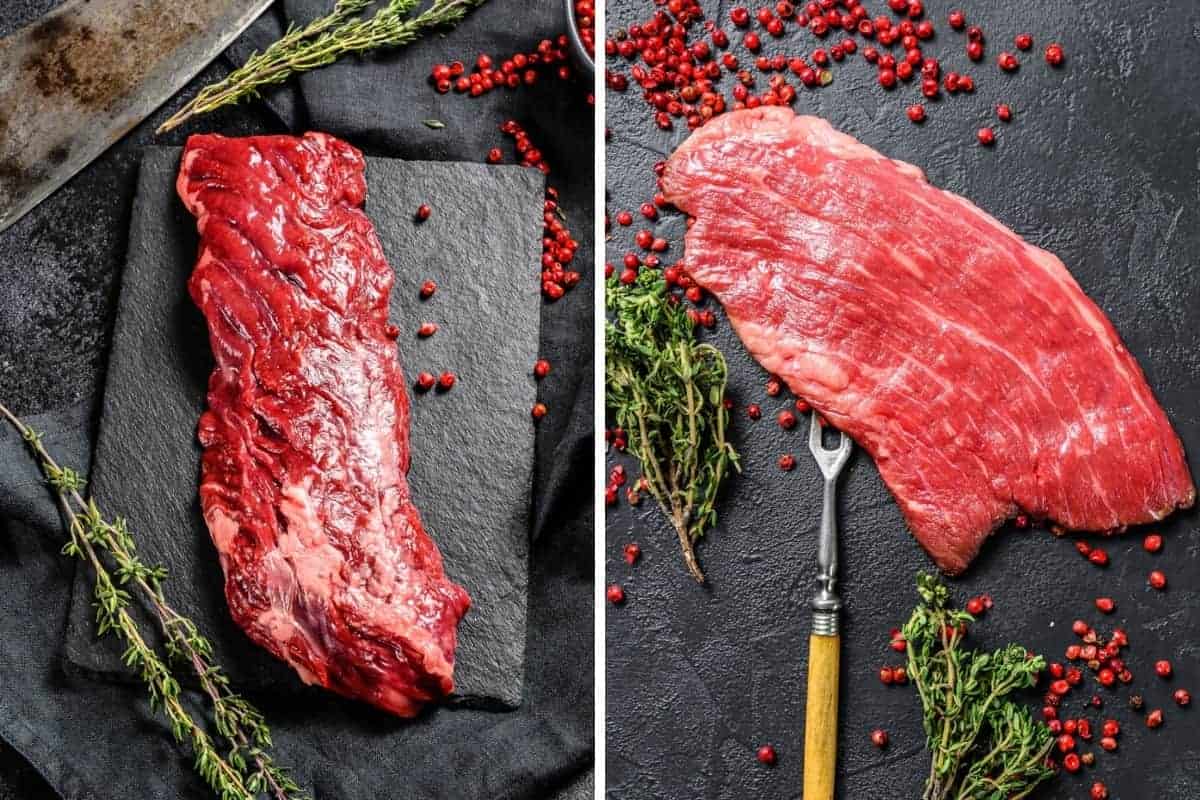
If you cannot find flank steak to use in a recipe, there are two cuts of meat that have the long striations of muscle similar to flank. They are hanger and skirt steaks.
Comparing skirt steak to flank steak, skirt is longer and thinner. It comes from the diaphragm muscles, and it is the most popular cut for the Mexican favorites, Carne Asada and Fajitas. It tends to have more fat than flank, making it juicier and more tender. It’s an uncommon cut, so you may have to ask the butcher for it or shop in a market that caters to shoppers from south of the border.
Hanger steak resembles skirt steak more than flank. It is long and thin with lots of fat between the muscles. They call this the “Butcher’s Cut” because there is only one steak like this per animal and the butchers would take it for themselves.
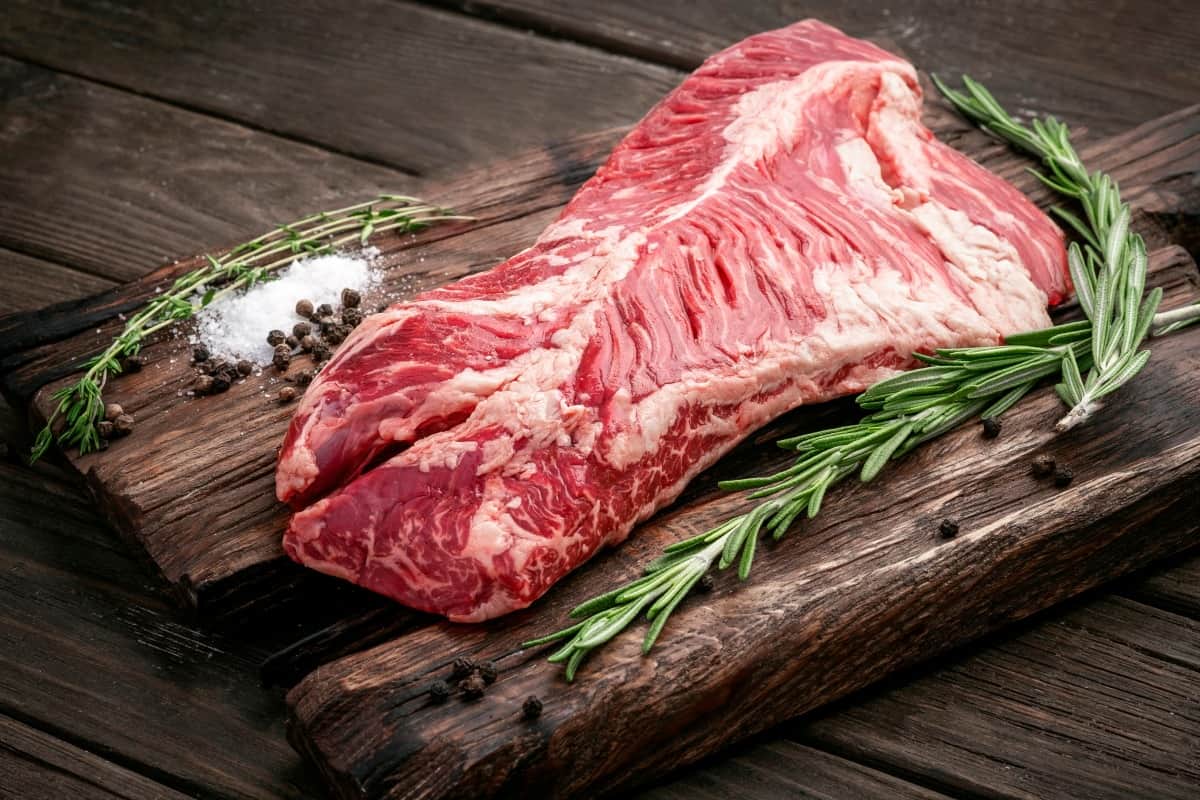
If you can’t find flank steak for your recipe, ask for hangar and treat yourself to a delicious cut of beef.
There is one other cut of beef that cooks use to substitute for flank in a pinch. It’s the flat iron steak. Although the lean muscle has the same long muscle fibers, they are much finer.
A flat muscle near the shoulder blade, the flat iron’s taste and texture are probably closer to that of the N.Y. strip than flank. You may find it labeled as a petite tender or a top blade steak.
If your recipe calls for flank, and you can’t find it, skirt steak and hanger steak are your best substitutes.
The Best Dishes for Flank Steak
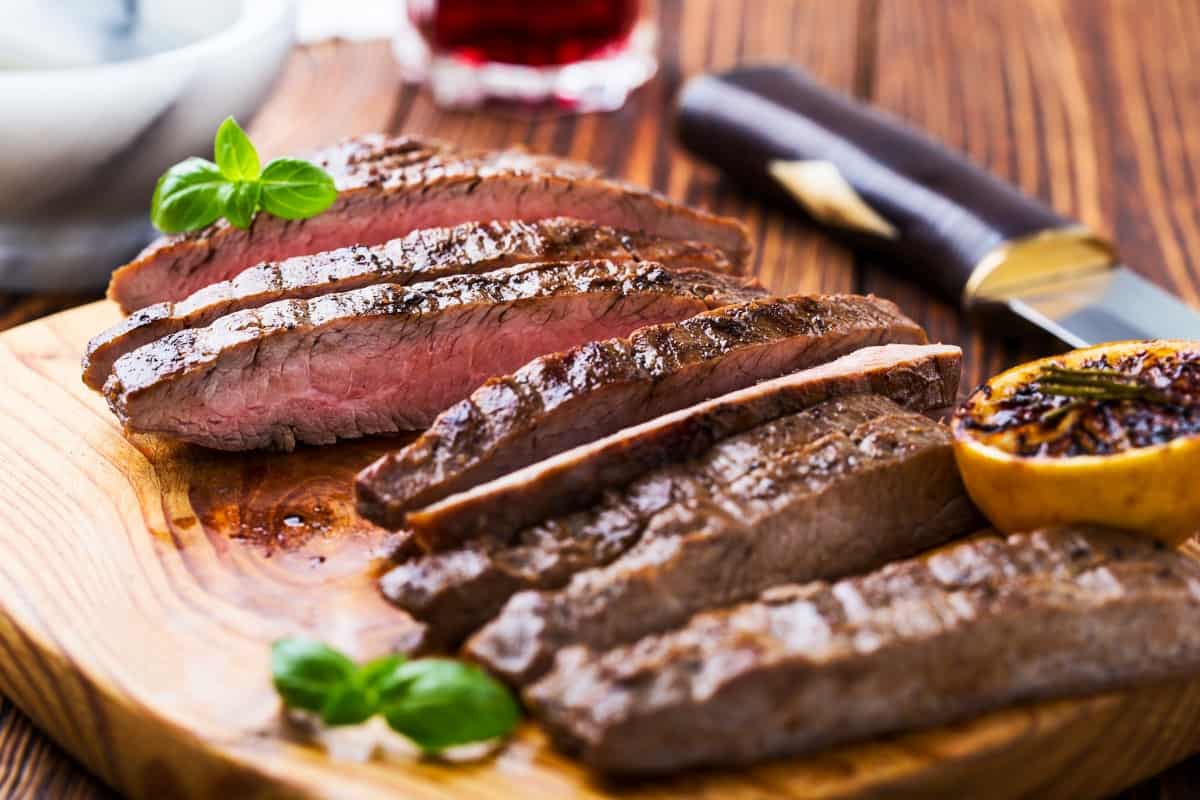
Marinated grilled flank can be a main course like any steak, except you’ll want to serve it thinly sliced instead of one whole piece.
It’s great in a sandwich too, hot or cold, and works really well with strong and hot sauces.
When it comes to braised dishes, use your imagination. From French or Central European braised roulades to Asian curries, and Mexican fajitas, flank will add another dimension of flavor and texture you won’t find in other tough cuts like chuck.
Buying Flank Steak
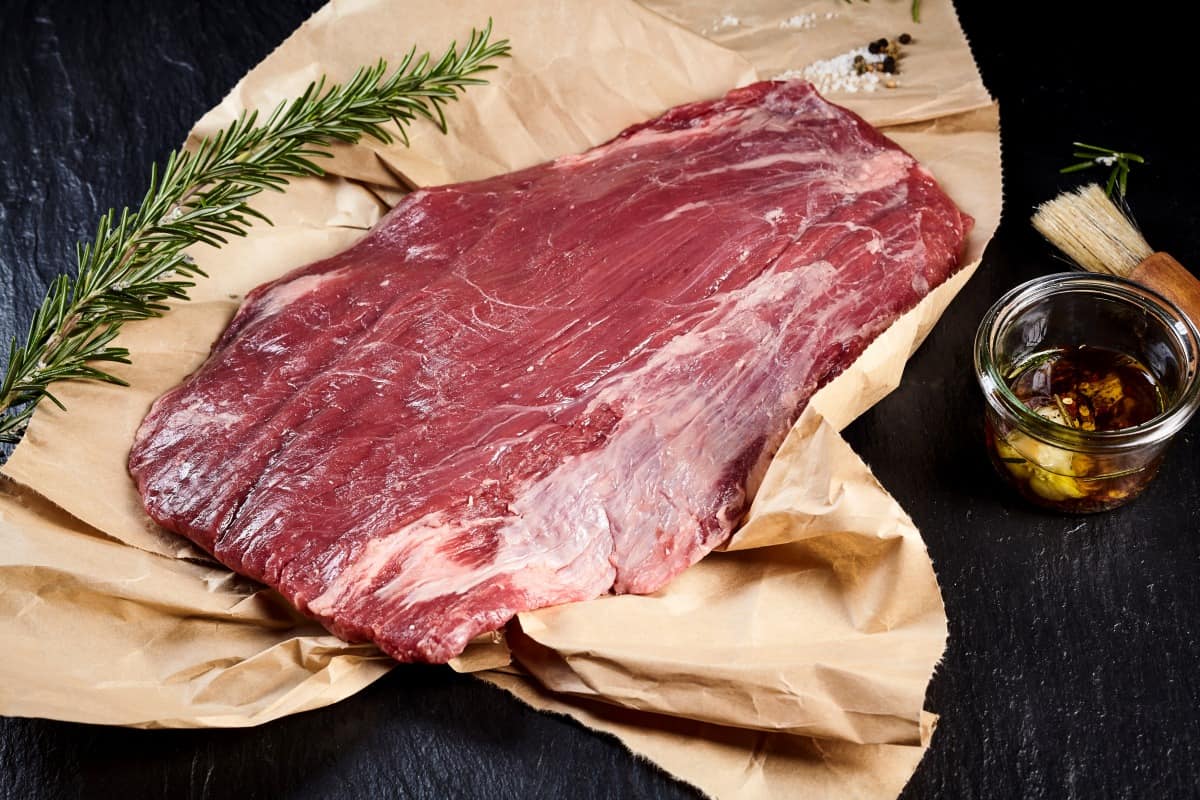
The meat of flank steak tends to be a deeper red color than other steaks like a N.Y. Strip or Ribeye steak. It will have long strands of muscle fiber running the entire length of the meat.
The color should be deep red with no holes, dark spots or brown discoloration. Brown means the meat has been exposed to air for too long.
There should be very little fat if any. Too much fat is a sign that it was not trimmed properly. You’ll see some connective tissue or “silver skin” on the thicker end. Again, this should not be excessive.
Where to Buy Flank Steak Online
Crowd Cow
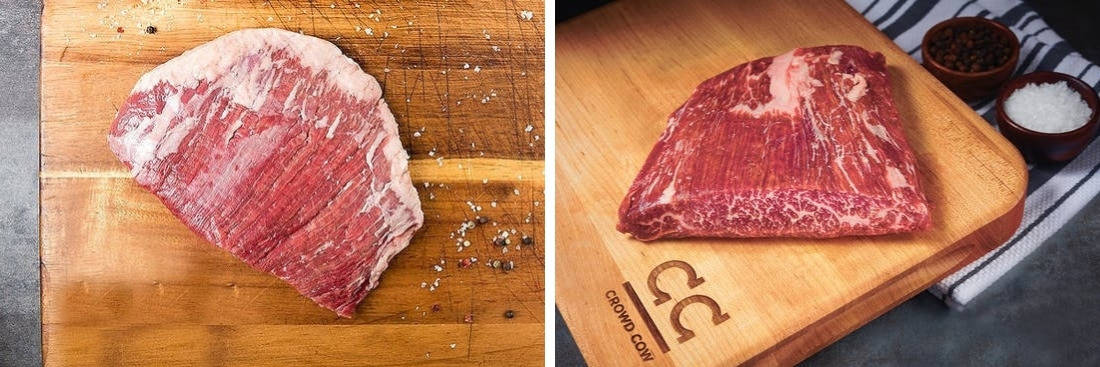
Crowd cow stocks three different varieties of flank steak for you to choose from: Pasture-raised and 100% grass-fed, which are both hormone and antibiotic-free, and a Wagyu cross from the Mishima reserve. These flank steaks come in at between 1 and 1.5lb in weight.
The grass-fed and pasture-raised steaks will have fantastic marbling, be flavorful, and full of meaty richness. On the other hand, the wagyu cross takes marbling to a new level, is a luxury product, and is significantly more expensive, so it’s best kept for special occasions.
Snake River Farms
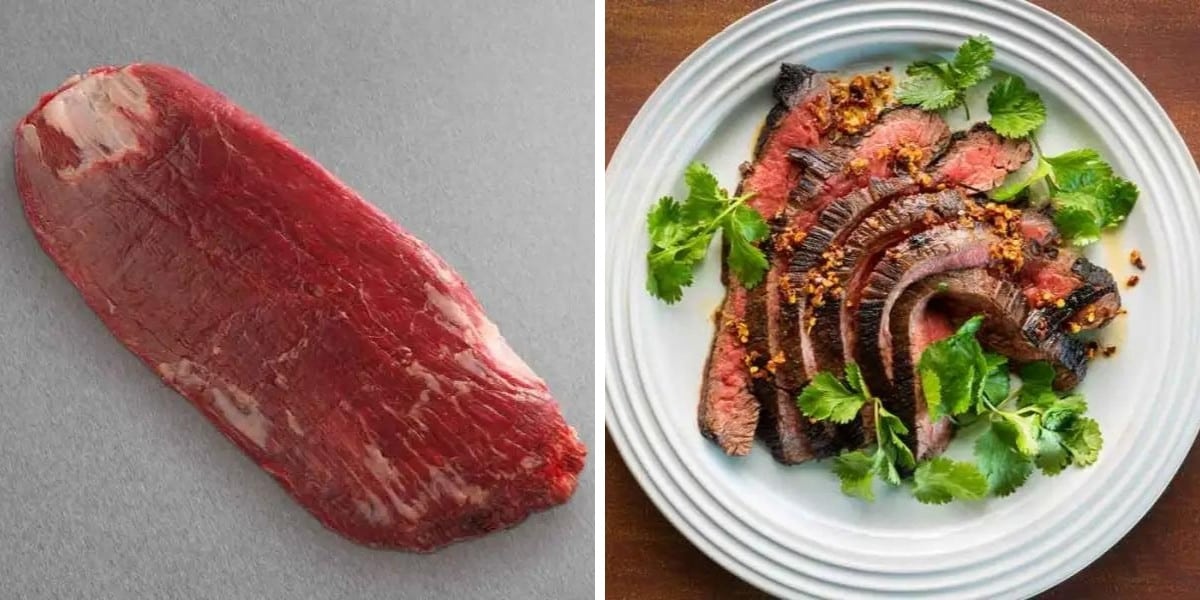
The flank steak from Snake River Farms is taken from their American Wagyu Black grade line of wagyu cross cattle, which has more intramuscular fat and marbling than USDA prime.
Each steak is cut to a consistent shape and averages 2 pounds in weight.
Check Price on Snake River Farms
Final Thoughts
If you’ve not tried flank steak before, please do give it a go. Variety is the spice of life as they say, so move away from your ribeyes and sirloins now and then and venture into these lesser used cuts, I promise you will like them!
If you found this article useful, please share it with your fellow chefs and grilling enthusiasts to help us get the word out about the site, we’d really appreciate it.
Happy grilling!


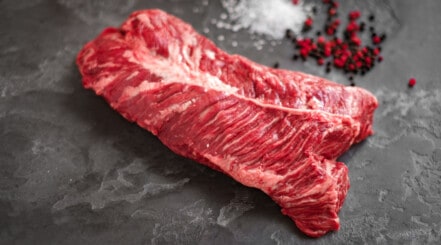
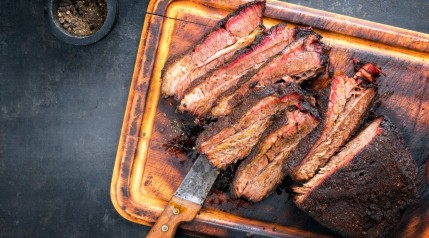


Very helpful
Thanks, Randy 🙂
Interesting comments on cooking, but all I needed to know was the ENGLISH NAME, so I know what to ask the butcher for, and no-one can tell me!!
Hi Pam,
It’s possibly a little less known in the UK, or could perhaps be known as Bavette, though I have, I’m afraid I have seen bavette used for skirt too in the UK (similar but different.)
What you can do is to describe to the butcher EXACTLY where on the animal it comes from, even print out an image and show them (or show them from your mobile phone). That should help a lot.
The info was very helpful. Looking to try flank in the future. Thanks.
This may be a dumb question — I’ve been buying larger cuts of meat and cutting steaks myself. When you BUTCHER a picanha, or a Vacio, a.k.a. flank, you cut WITH the grain to make your steaks. Then after you COOK it you cut AGAINST the grain to eat it — is that correct?
Hi Mitchell,
Steaks are butchered from the larger cuts going more on the shape of the sub-primal — and desired shape of the steaks cut from it — rather than any considerations for the grain. Generally speaking, you can see in ribeye, sirloins etc. that it is cut with the grain somewhat. You can see the grain going lengthwise in many steak cuts, which makes it so you can slice against while eating.
Your article was quite helpful. I want to try a new recipe, didn’t know that much about flank steaks, and now I do. Thank you, so much.
Thanks, Vivian 🙂
Thanks for the differentiation between skirt and flank. I appreciate your thoroughness in noting the anatomy, texture/ grain/ muscle characteristics, the best techniques for tenderness- cooking and slicing recommendations. I feel better prepared!
Thank you very much for the article. I’m looking forward to my next Flank Steak experience !!!!!!! Thanks, again!!
Tom
This is a great article. It helped me understand the differences in these steaks. Thanks, so
much.
Very helpful I will give it a try
My Mother, who was an excellent cook, would make flank steak braised and rolled with homemade bread dressing inside the rolled meat. It was held together with skewers like the ones used in roasting turkey. When roasted fairly well done and sliced while rolled with the dressing inside each piece, it is delish. Gravy can also be made from the meat juices. Love to have it when I’m hungry for dressing, but not associated with roast turkey.
In what universe are a flank steak and a London Broil the same cut of meet. You obviously don’t have a clue what you are talking about!
Hi ‘BikerGriller’,
Please go to google, and enter “is london broil a flank steak”. Have a skim read of the top 10 or 20 results.
Thanks for your help. Maybe now I can find what I am looking for in the market. Knowing the other names for flank steak is very helpful. Thanks
Thank you so much for terrific info. I will now go find some. Been at a loss.